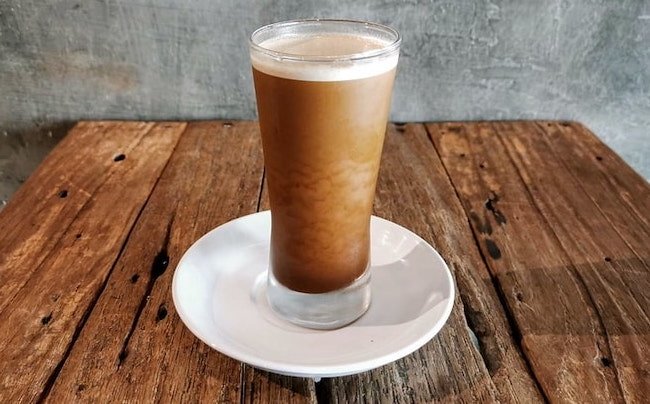If you’re a real coffee lover, there is only one way to drink your coffee, and that is hot. Or at least lukewarm.
However, even the most diehard coffee dogmatist can succumb to the heat of a post-global warming summer.
In those instances, it’s acceptable to chug down a cold brew or Japanese Ice coffee.
One of the newest trends in the world of chilled coffee is to infuse it with nitrogen. This concoction is usually called ‘nitro coffee’ or just ‘NCB.’
In this article, I’ll analyze nitro coffee from a coffee snob’s perspective and tell you everything you need to know
What is nitro coffee
As the name implies, nitrogen is added to coffee and served chilled. Why would you want to do that in the first place?
Well, because it gives the beverage a pleasant and creamy mouthfeel.
Just imagine a Guinness draft beer mixed with cold brew coffee, and you immediately know how a nitro coffee tastes. Bubbles and creaminess are just winning combination.
Nitrogen coffee facts
- Cold brew coffee is infused with either pure nitrogen or a mix of gasses and served on tap similar to beer
- The coffee will have a big ‘head’ like a Guinness beer and take on a cappuccino color when poured even though no milk has been added.
- The concoction is high in caffeine and has less than 5 calories per serving
- Nitro coffee is quite profitable for coffee shops. It’s neither labor intensive for baristas nor taking up expensive space in the fridge.
- Once in the keg, the coffee will oxidize at a slower rate. It can stay fresh for two weeks
Traditionally, the head in beer is created by carbon dioxide produced during the brewing process. However, Guinness invented a method where beer was drawn from a keg and mixed with nitrogen. This creates a more substantial head as well as a less acidic and more round flavor compared to relying on carbon dioxide alone.
The origins of nitro coffee are slightly vague. Some people claim that a frustrated barista at the New York café “The Queens Kickshaw” complained about the cold brew setup, and was then told by the owner just to put it on tap next to the beers.
Other people credit the food scientist Nate Armbrust from the legendary roaster, Stumptown Coffee with the invention. (Source)
Is nitrogen infused coffee better?
Some people (IMHO mostly clickbait hungry bloggers) claim that nitro coffee tastes better and is more healthy than regular coffee.
Unfortunately, none of these claims make sense upon closer inspection:
- Because nitrogen coffee by default is made with coffee that has been brewed a while ago, some of the volatile aromas will be lost when you taste the brew.
- When you serve coffee cold, you’re making it more difficult to discern between different flavor notes.
- Nitrogen doesn’t add any flavor it just changes the mouthfeel and your perception of the drink.
- The flavor is mostly determined by the beans used, and less by the preparation.
If you have tried drinking an old, stale beer at room temperature, you know how chilliness and bubbles alter the who experience. From aweful to awe-inspiring.
Chilling and bubbles make many drinks more palatable but saying that it beats regular coffee made on high-end beans is taking things too far.
It might taste better than average diner coffee that’s been left on the burner all day, but that’s not really saying a whole lot.
I’ll stick with my carefully brewed pour over coffee most of the time (unless it’s a super sunny day).
As for health benefits, they are even more far-fetched. Allegedly, you don’t need to add sugar to a nitro because of the texture. However, that doesn’t make it healthy; it just means that it’s not as unhealthy as certain other coffee concoctions (I’m looking at you, frappuccinos!)
An ice americano or Japanese Ice coffee, or almost any black plain coffee, is similar to nitro when it comes to calories.
How to make Nitro cold brew coffee the proper way
Nitrogen itself is just a chemical element, so what matters in the flavor is the quality of the beans and how the coffee that is going to be infused is brewed in the first place.
- If you use cold brew as the base, which many people do, the resulting beverage will be very smooth and have almost no acidity. Personally, I find that approach boring.
- You can improve the nitro by mixing in some coffee brewed with hot water. That will make it more bright and exciting.
If you use a premium coffee, there should be no reason to use sugar. The beans will already have sufficient sweetness.
Nitro has the potential to be tasty if it’s made on well-extracted coffee beans and infused with a bunch of nitrogen. Unfortunately, it’s more often than not just a sloppily brewed cold brew with a bit of a fizz.
FAQ
No, nitro coffee is actually more healthy than common drinks such as lattes and macchiatos, since it usually has less sugar and calories. Of course, you should consume with moderation.
Nitro cold brew is made by infusing the base blend with nitrogen to give it a rich, velvety head, like that of nitro draft brew, for example, Guinness. Nitrogen (N2) bubbles are littler than carbon dioxide (CO2) bubbles and, when imbued in the espresso, give it a rich mouthfeel.
Yes, nitro coffee is perfectly safe to drink under normal circumstances, as long as the coffee shops follows normal hygiene practices.
